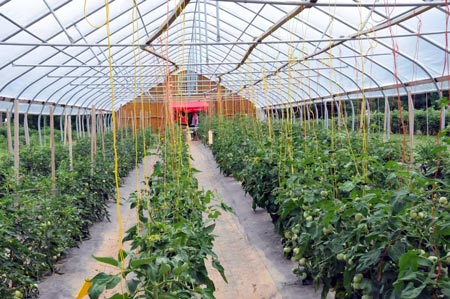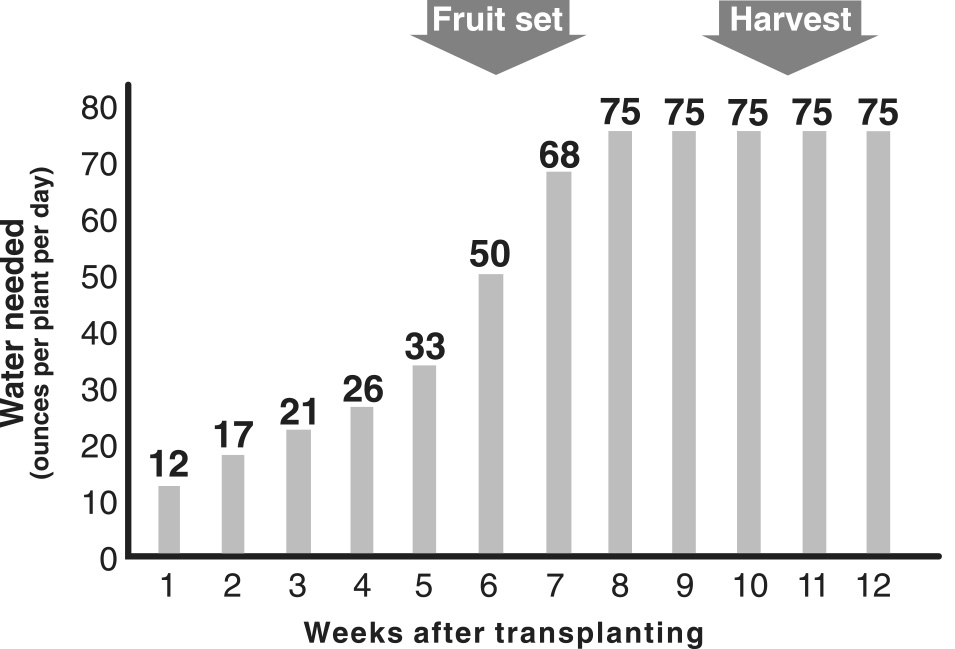
Proper watering and fertilization are essential for producing tomatoes in a high tunnel. High tunnels keep out natural rainfall, so timely irrigation is necessary. Additionally, growers must consider the special needs of high-tunnel soil to ensure availability of appropriate levels of nutrients.
Drip irrigation
Drip irrigation is the most efficient method of delivering water and nutrients to high-tunnel tomatoes. Plants are watered slowly through a small, ¾-inch-diameter collapsible tube without wetting the foliage. Drip tape, usually 8 to 10 millimeters thick, is buried 1 to 2 inches deep. Dripper or emitter spacing is typically 4 to 12 inches. Tomatoes require a single drip line per row, offset about 2 inches from the plant. Flow rates of drip tapes vary. Most growers choose a medium-flow tape, which delivers half a gallon per minute (gpm) per 100 feet. High-flow tape, which delivers 0.8 to 1.0 gpm, is useful for preventing clogging and reducing irrigation time (Table 1).
Another distinct advantage of drip irrigation is the capacity to inject water-soluble nutrients through the irrigation system, a technique called fertigation. This technique allows nutrients and water to be applied as the crop grows, rather than all of the nutrients being applied at once, either during or before planting (Figure 1). Fertigation saves both water and fertilizer.
Table 1. Irrigation hours per week required to apply 68 ounces of water per tomato plant per day based on varying plant populations and drip tube flow rates.
| Drip tube flow rate | Tomato plants per high tunnel | |||
|---|---|---|---|---|
| Gph/100 ft1 | Gpm/100 ft2 | 300 | 400 | 500 |
| 8 | 0.13 | 21 | 28 | 35 |
| 10 | 0.17 | 17 | 22 | 28 |
| 12 | 0.20 | 14 | 19 | 23 |
| 16 | 0.27 | 11 | 14 | 18 |
| 18 | 0.30 | 9 | 12 | 16 |
| 20 | 0.33 | 8 | 11 | 14 |
| 24 | 0.40 | 7 | 9 | 12 |
| 30 | 0.50 | 6 | 8 | 9 |
| 36 | 0.60 | 5 | 6 | 8 |
| 40 | 0.67 | 4 | 6 | 7 |
| 42 | 0.70 | 4 | 5 | 7 |
| 48 | 0.80 | 3.5 | 5 | 6 |
| 60 | 1.00 | 2.8 | 4 | 5 |
| 1Gallons of water per hour per 100-foot run of drip tape. 2Gallons of water per minute per 100-foot run of drip tape. |
||||
Watering

Because tomatoes are more than 90 percent water, yield and quality suffer when plants suffer under drought conditions. Inadequately watered tomatoes develop fewer flowers per truss, produce less fruit and often contract blossom-end rot.
Critical growth periods for adequate watering of tomatoes are during flowering, fruit set and fruit development. Flowers begin to appear on tomato plants about four weeks after transplanting. Determinate tomato varieties have a concentrated period of flowering, whereas indeterminate tomatoes flower continuously during the growing season. Tomato plants begin developing fruit about six weeks after transplanting, and adequate watering is necessary for the fruit to develop and grow to a proper size. An average of 2 to 2 1⁄2 quarts of water per plant per day will be needed as the fruit continues to grow (Figure 2). This water requirement comes out to more than 1,000 gallons per week for a high tunnel containing 300 tomato plants.
Fertilization
Many water-soluble fertilizers can be used for tomatoes. However, large quantities of phosphorus and potassium generally should not be applied through the drip irrigation system. Rather, the soil should be tested before the crop is planted, preferably in the fall, and all of the phosphorus and most of the potassium can be applied before planting or between cropping cycles within the high tunnel. The decision to apply additional phosphorus and potassium via drip irrigation should be based on tissue test results.
Nitrogen is used by tomato plants for vine growth. Tomato plants low in nitrogen appear stunted and spindly with a yellowish cast to the leaves. Too much nitrogen creates excessive vine growth, twisted foliage, delayed flowering and lower yield. About 40 to 50 percent of the total seasonal nitrogen can be applied at planting, and the remaining balance can be applied through the drip system over the course of the growing season. Many organic sources of nitrogen, such as alfalfa and soybean meal, and compost can be mixed with the soil before planting.
For each 1 percent of organic matter in the soil, as much as 20 pounds per acre of nitrogen can be released on an annual basis. If soil organic matter content is greater than 3 percent, no nitrogen is necessary before planting. However, if soil organic matter is less than 3 percent and no organic residues have been added to the soil, 1 to 1.5 pounds of actual nitrogen per 1,000 square feet can be applied before transplanting tomatoes in the high tunnel.
Fertigation of nitrogen can be applied based on the volume of water applied by irrigation or based on area. Most tomato roots will be concentrated in a 24-to-30-inch-wide section of the bed or row. Multiply the root zone width by the length of each row and the total number of rows to determine the effective bed width. Additional nitrogen can be applied through the drip irrigation system at a rate of 8 to 10 pounds per acre per week, or 2.9 to 3.7 ounces per 1,000 square feet per week (Table 2). Foliar feeding of nitrogen, phosphorus and potassium is not as effective as soil application of these major nutrients. Nitrogen fertilizer is available as nitrate or ammonium. Tomatoes respond favorably to nitrate nitrogen, which is readily available to the plant and typically has low salt relative to ammonium fertilizers, such as ammonium nitrate and urea. Choose low-salt nitrogen fertilizers because salt levels can accumulate in high-tunnel soil. Many commercial high-tunnel tomato growers choose to fertilize with calcium nitrate and alternate weekly with a high-potassium fertilizer (4-18-38), particularly during ripening. Calcium reduces the incidence of blossom-end rot, and some indicators suggest potassium might improve fruit quality.
Conduct tissue testing to determine whether tomato nutrient levels are sufficient. Randomly select 10 to 12 plants per house beginning at flowering or early fruit set. For determinate tomatoes, such as Mountain Fresh Plus, break the fifth or sixth limb from the top of the plant and place the entire limb in a brown paper bag. For indeterminate tomatoes, such as Bigdena, choose a leaf above a fruit that is about 2 inches in diameter. Dry the sample before sending it to a laboratory for analysis. Compare results with recommended levels of each nutrient (Table 3).
Table 2. Amount of water-soluble fertilizers used to fertigate producing high tunnel tomatoes.
| Nitrogen required | Equivalent rate of commercial nitrogen fertilizers (ounces per 1,000 square feet) | ||||
|---|---|---|---|---|---|
| Pounds per acre equivalent | Ounces per 1,000 square feet | 15-0-0 | 20-20-20 | 4-18-38 | 9-45-15 |
| 4 | 1.5 | 9.9 | 7.3 | 36 | 16 |
| 6 | 2.2 | 15 | 11 | 55 | 24 |
| 8 | 2.9 | 19 | 15 | 73 | 32 |
| 10 | 3.7 | 25 | 19 | 93 | 41 |
Table 3. Recommended tissue levels of nutrients for high tunnel tomatoes.
| Element | Early fruit set | Mid-harvest |
|---|---|---|
| Nitrogen (N) | 4.0 to 6.0 percent | 4.5 to 5.5 percent |
| Phosphorus (P) | 0.3 to 0.9 percent | 0.6 to 0.8 percent |
| Potassium (K) | 4.0 to 7.0 percent | 4.0 to 7.0 percent |
| Calcium (Ca) | 1.5 to 3.5 percent | 1.5 to 5.0 percent |
| Magnesium (Mg) | 0.4 to 0.7 percent | 0.4 to 1.5 percent |
| Iron (Fe) | 60 to 300 ppm | 60 to 300 ppm |
| Zinc (Zn) | 30 to 100 ppm | 30 to 150 ppm |
| Boron (B) | 30 to 100 ppm | 30 to 100 ppm |